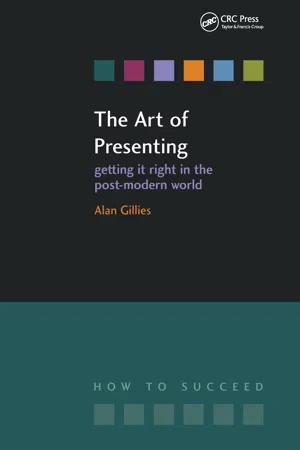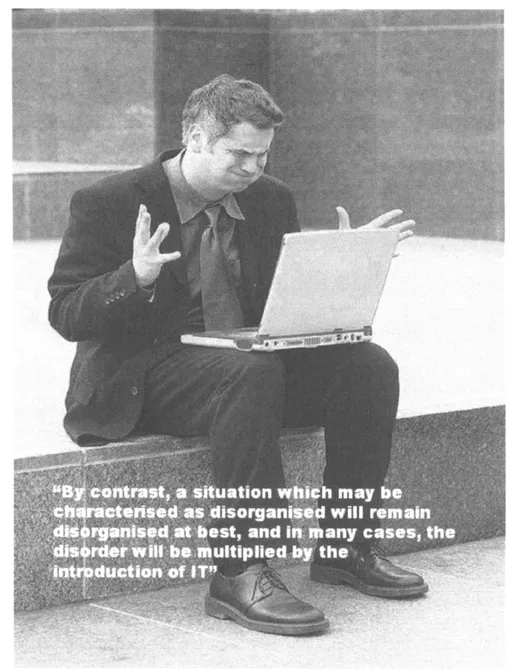
eBook - ePub
The Art of Presenting
Getting It Right in the Post-Modern World
Alan Gillies
This is a test
Compartir libro
- 128 páginas
- English
- ePUB (apto para móviles)
- Disponible en iOS y Android
eBook - ePub
The Art of Presenting
Getting It Right in the Post-Modern World
Alan Gillies
Detalles del libro
Vista previa del libro
Índice
Citas
Información del libro
This informal, fun guide is ideal for anyone involved in public speaking; addressing a group of people in a wide range of situations including lecturing as part of your day job, presenting research findings to your academic peers, and presenting to potential future colleagues as part of an interview process. These situations are all different, and as with many things, context is everything. Whether you're working with large or small audiences, there are basic rules for speaking that should never be overshadowed by bewildering presentation technology.
Preguntas frecuentes
¿Cómo cancelo mi suscripción?
¿Cómo descargo los libros?
Por el momento, todos nuestros libros ePub adaptables a dispositivos móviles se pueden descargar a través de la aplicación. La mayor parte de nuestros PDF también se puede descargar y ya estamos trabajando para que el resto también sea descargable. Obtén más información aquí.
¿En qué se diferencian los planes de precios?
Ambos planes te permiten acceder por completo a la biblioteca y a todas las funciones de Perlego. Las únicas diferencias son el precio y el período de suscripción: con el plan anual ahorrarás en torno a un 30 % en comparación con 12 meses de un plan mensual.
¿Qué es Perlego?
Somos un servicio de suscripción de libros de texto en línea que te permite acceder a toda una biblioteca en línea por menos de lo que cuesta un libro al mes. Con más de un millón de libros sobre más de 1000 categorías, ¡tenemos todo lo que necesitas! Obtén más información aquí.
¿Perlego ofrece la función de texto a voz?
Busca el símbolo de lectura en voz alta en tu próximo libro para ver si puedes escucharlo. La herramienta de lectura en voz alta lee el texto en voz alta por ti, resaltando el texto a medida que se lee. Puedes pausarla, acelerarla y ralentizarla. Obtén más información aquí.
¿Es The Art of Presenting un PDF/ePUB en línea?
Sí, puedes acceder a The Art of Presenting de Alan Gillies en formato PDF o ePUB, así como a otros libros populares de Business y Human Resource Management. Tenemos más de un millón de libros disponibles en nuestro catálogo para que explores.
Información
1 | Introduction: the three eras of presentation |
Era 1: The pre-modern era of presentation
In the good old days, we are told that public speakers could produce oratory that would hold the attention of people for hours on end without any recourse to artificial aids whatsoever. As with most nostalgic visions of a golden age in the past, it is only partially true.
There is good evidence of the power of the great orators. The good: Martin Luther King captured on film in 1963 at the Lincoln Memorial speaking to 250,000 people with his ‘I have a dream’ speech; the bad: Adolf Hitler, spreading hatred through his oratory in the 1920s and 1930s; and the short: John Wesley, the Oxford don, just 5 foot 3 inches tall going out to preach to the illiterate miners of Bristol and attracting nearly 8,000 on his first Sunday alone in April 1739.
 | Some of the great oratory of the twentieth century has been captured on film and has been made available on the Internet. Contact me for details of where to see Martin Luther King’s 1963 speech for example. |
On the other hand, this view belongs to the same golden age where the local bobby cycled around preventing local youths from becoming drugs barons by a simple clip around the ear. For every great orator, we can remember the occasions when we have been bored to tears. I remember being on a course for new lecturers where we were learning about teaching, and a colleague announced: ‘Well the problem is, I have the most boring part of the syllabus to teach!’ This was almost certainly a self-fulfilling prophecy! I was glad I wasn’t one of his students.
Graphics to accompany talks were either hand written, typed or photographic slides. The overhead projector allowed speakers to illustrate their talks with words and sketches in hideous shades of mauve.
Viewed from the present, much of the activity of even 20 years ago looks hideously old-fashioned. There are almost certainly increased expectations on the part of listeners these days. Many people are seeking to communicate with them in very sophisticated ways. Today’s children live in a world of instant, high-quality media. We are also dealing with a much less deferential society. In many cases, listeners will not sit still to be politely bored, and if they do it once, they will do it no more than once.
As an undergraduate, I was part of a group of 180 students. For the first week of a lecture course it was normal for about 100 students to turn up. Over the next few weeks the numbers either rose to about 120 as good reports spread, or started to drop. There was one lecturer who was rumoured to have been very close to receiving a Nobel prize. However, his lecturing style was such that by week 5 there were only 11 students left. Two weeks later, he was into single figures apparently. I cannot speak from first hand because I had given up by that point.
Some readers may be shocked by this and feel that more pressure should have been exerted to make attendance compulsory. Apart from the flippant observation that human rights conventions were introduced to stop such abuse, surely the more appropriate response is to seek to improve the quality of communication. There’s no point in enforcing attendance if no communication takes place. And students did attend if they felt it was worthwhile.
Another lecturer had written a book based on his lectures: it was sufficiently close to the content of the lectures that at the end of each session you could agree with colleagues that he had reached the bottom of page X. And yet he achieved very good attendance because his lectures added understanding to the written word on the page.
Characteristic of this era of presentation was a great variation in the quality of public speaking. The best was wonderful, the worst was truly awful.

As with many other activities, the computer has revolutionised the way that we do public speaking.
- What do you think are the advantages?
- What do you think are the disadvantages?
Era 2: The modern era of presentation
One response to this problem is to use presentation graphics software to provide a presentation to illustrate the talk, and maybe give out hand-outs of the slides as an aide memoire. Unfortunately, this superficially attractive theory does not stand up in practice.
There is a truism in IT (information technology) that if you introduce computers into a situation that is well organised, understood and structured, then a properly designed and implemented IT system will make things better. By contrast, a situation that may be characterised as disorganised will remain disorganised at best, and in many cases, the disorder will be multiplied by the introduction of IT.
Thus a disorganised and unclear talk is likely to be illustrated by slides that are cluttered and incomprehensible. A boring talk is usually accompanied by even more boring slides!
A computer with a presentation graphics package is a tool. Think about digging a hole in the road. Is a pneumatic drill a better tool than a pick and shovel? Well that depends. It’s a more powerful tool, but it all depends on what you are going to do with it. If you are skilled in its use, it will undoubtedly speed up your task. If you’re as clumsy as I am, and whatever you use is as likely to make a hole in your foot as the road, then the more powerful tool will simply do more damage. If you think this is a foolish example, then consider the following ways in which presentation graphics packages can add to the portfolio of sure-fire ways to ruin your talk, all of which I have seen.
- The speaker who has no concept of time management can now add the crime of producing far too many slides, thus ensuring that they run over time, and that anyone with a hand-out will know in advance that they don’t stand a chance of sticking to time.
- The speaker who cannot structure a talk is unlikely to suddenly acquire the skill of structuring a slide, and will often produce spectacularly cluttered slides.
- The speaker who prizes uniformity above all and speaks in the same dull monotone will likely produce screen after screen of uniform bulleted lists, which will only serve to reinforce the complete lack of variation in the whole presentation.
And I could go on, but you would quickly become bored with my bulleted list. When I sit in the audience of such talks, I am reminded of a song I learnt in childhood.
 | Little boxes on the hillside, little boxes made of ticky tacky. Little boxes, little boxes, little boxes all the same. There’s a green one and a pink one and a blue one and a yellow one, And they’re all made out of ticky tacky, and they all look just the same. Malvina Reynolds |
 | The illustrations used in this book are available in colour from the author as a PowerPoint presentation. |
And I can’t help thinking of a version for today’s presenters:
Little lists made up of bullets, little lists made out of tittle tattle.
Lists of bullets, lists of bullets, lists of bullets all the same.
There’s a logo and a title and a bullet and another one,
And they’re all made out of tittle tattle, and they all look just the same!
With apologies to Malvina Reynolds

Just as enforcing attendance at my undergraduate lectures would not have improved communication and could have made matters worse by making the audience restive and the lecturer nervous, so giving people powerful tools without sorting out the underlying issues is a bad idea. It is the presentation equivalent of giving me a pneumatic drill!
To improve the quality of talks, you must first sort out the fundamentals of presentation: check that you as the speaker have a grasp of how to plan a talk, structure a talk and deliver a talk. Having established the fundamentals, it is likely that you will be able to enhance your talk with the appropriate tools and avoid the equivalent of shooting (or drilling!) yourself in the foot.
If you think about other arenas, then first we learn the rules to guide us on how to act competently. However, if we wish to progress beyond competence to expertise, then a key skill we need to learn is how to use judgement on when to go beyond the rules.
Consider a model of how we move from being a novice to an expert, adapted from the work of first Dreyfus and Dreyfus (1980), refined by Benner (1984) and Storey et al. (2002) (see Table 1.1). A novice oper...